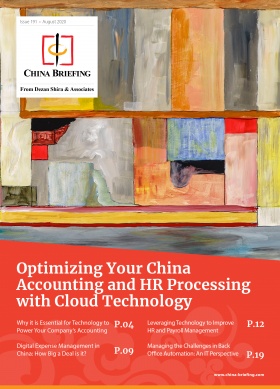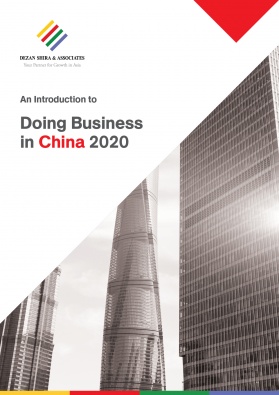Corporate Budget Planning 2021: Disruptions, China’s Consumer Market, Emerging ASEAN, the Digital RMB, and BRI Hot Spots
Op/Ed by Chris Devonshire-Ellis

Dezan Shira & Associates held a virtual partners’ meeting yesterday to discuss planning for 2021. Our firm – which has been assisting foreign investors in Asia since 1992 and now has close to 30 regional offices and staff running into hundreds – has dealt with billions of dollars’ worth of regional foreign investment during this time. We are, of course, foreign investors ourselves, and with an Asian geographical spread and corporate client base of the type we have, are a bellwether for how foreign investment trends are progressing in the region, especially as the bulk of our clients are from North America and Europe.
Obviously 2020 took planned corporate budgets by surprise, chewed them up and spat them out in a COVID frenzy of radically altered expectations. Sales targets have been dumped, production facilities mothballed, and staff told to work from home. Yet, at the same time, corporate spending has decreased, meaning for many a reduction of revenues that has been offset by a reduction in expenses. Economically, things have not been as bad as they could have. But where does this leave businesses when trying to plan for 2021?
Clearly, the COVID factor is not going to disappear any time soon. While 10 months on we may have a greater understanding of how the virus operates, and how social discipline can hinder its spread – there is no realistic timeline in sight for a workable vaccine. Bill Gates, financing much of the research, has suggested this year end, while Dr. Anthony Fauci, the United States’ primary medical advisor, has suggested any preventative vaccine will not be widely available until the second or third quarter of 2021. As of right now, no widely tested vaccine is available, although both China and Russia are progressing with clinical trials. What this means is that while vaccines might be ready later this year, getting them out to the global population is going to be a massive supply chain issue. It is unrealistic that any significant progress will be made until well into 2021, and even then, new cases and spikes will emerge over the coming months and into the new year. The best one can suggest in terms of business preparedness is that 2021 will again be disruptive. That means careful, considered budgetary planning is essential as we start to assess how to structure business finances leading into the next year. However, there are some predictable and even bright spots that corporate financiers can take into consideration when looking at potential for 2021.
The US election
It is not the best timing to have the world’s most influential economy lining up to elect a president, and especially given the existing political turmoil. However, no matter who wins, our view is that nothing much will change in the short term. If Donald Trump prevails, more of the same, and if Biden wins, it will take him much of next year just to work out where to begin. Accordingly, we do not expect the US election to have any noticeable impact on global trade in 2021, and much will remain the same. The result can therefore be discarded from any significant non-US corporate planning.
China
The most influential factor here will remain the impact of the current state of US-China trade relations. There has been considerable damage caused to US sourcing and manufacturing businesses focused on China with clients based in the US. Some have gone into liquidation, others may follow; we have had to deal with numerous cases of liquidating businesses in China this year. Our complimentary magazine How to Close a Business in China deals with exactly this situation. Some unnecessary corporate blood has been spilled.
On the positive side, many of these businesses have relocated their sourcing and manufacturing operations elsewhere, with Vietnam an especially popular choice. Our Vietnam offices have experienced rapid growth over 2020, and we have incorporated a record number of foreign-invested companies there this year. Our complimentary magazine A Guide to Vietnam’s Supply Chains examines where new sourcing structures can be built.
Meanwhile, China itself remains a hugely buoyant market. While the economy took a battering in Q1 this year, every month since then has seen a return to normality and growth. The World Bank expects the Chinese economy to grow by nearly eight percent in 2021 and our China offices have been busy servicing new incorporation for foreign investors. This is because consumer demand is increasing. It is true that the figures for the whole of 2020 will be impacted, but the fundamental trend is optimistic. China’s middle-class consumer base is still growing – and is on track to reach 550 million people by 2023. That is 150 percent the size of the entire population of the United States. This means that a significant opportunity for 2021 remains investing in China and selling and manufacturing products and services to the China market. Another pointer towards this comes from a lesser understood source – the Belt & Road Initiative. This year, China imported more from Belt & Road Countries than it exported. Capital Economics meanwhile have just released data stating that China’s imports grew by 13.2 percent last month, signaling a huge return of Chinese consumer demand. Despite the trade war, imports from the United States are up 24.7 percent on last year, while new agreements with the European Union should also make China market access easier in certain sectors. Selling to China and investing in structures to exploit this potential should be a key component of any corporate 2021 sales and growth budget.
The emerging ASEAN markets
Dezan Shira & Associates has a significant presence in ASEAN, with operations in Indonesia, Malaysia, Philippines, Singapore, Thailand, and Vietnam. While intra-ASEAN trade is understandably down this year as borders closed and lockdowns were enforced, we again maintained a healthy level of client incorporations in these markets. This was driven by two main factors, again the spill-over from the US-China trade war and the repositioning of sourcing and manufacturing businesses away from China as the search for US-friendly export alternatives increased, and the latent consumer potential. In terms of relocating businesses from China to ASEAN, we examined the different options and available incentives in our complimentary publication Relocating Your Business from China to ASEAN.
With respect to ASEAN as a consumer growth market in its own right, over 380 million people in the region are under 35 years old, being roughly 20 percent larger than the entire population of the United States. ASEAN also has the world’s third largest labor force, trailing only China and India while ASEAN’s middle-class is expected to more than double in size from 135 million to 334 million by 2030. While it is true that certain ASEAN nations fared better than others in 2020 and during the COVID outbreak, all maintain significant growth potential. Of the ASEAN manufacturing champions, Thailand and Vietnam were most effective at closing their borders early, preventing the spread of the disease, and maintaining their domestic economies. Singapore was also highly disciplined and remains the regional business, administration, and financial hub. Our office there again had a record year in handling foreign investment for the region and liaises closely with our other ASEAN offices.
In the wake of COVID-19, ASEAN countries also provided a diverse range of investment incentives for investors, which are still in place and expected to remain well into 2021. We examined these in our complimentary magazine Business Recovery in ASEAN After COVID-19. ASEAN is also a market that global investors should be considering for 2021 – the Asian Development Bank has indicated it expects ASEAN GDP to grow by eight percent next year. For advice and ASEAN market comparisons, our Singapore office will be happy to help.
Exploiting the Belt & Road Initiative
We understand that China’s Belt & Road Initiative is a hugely contentious issue and a vast amount of (mainly Western media) criticism has been thrown at it. However, debt trap accusations have now largely been debunked, and in 2020 we saw that many of the projects China has invested in over the past five years are now coming to completion. In turn, that means that opportunities exist across the BRI in terms of foreign investment. An example is Sri Lanka’s Southern Expressway, which connects the capital, Colombo, to the golden beaches of the South Coast. Flying into Colombo and then driving down to the south used to take five hours – now it is a 90-minute jaunt. Although China’s State Construction Engineering Corporation (CSCEC) made a fortune in building the road, the impact on Sri Lanka’s tourism industry has been huge. Hotels, restaurants, taxi firms, tour operators, and so on have all combined to push the annual tourism revenue in Sri Lanka up by several billion dollars per annum. It is within this post-BRI infrastructure build that opportunities lie.
The BRI is now moving into a second, and more international investor-friendly, phase – global investors now have the opportunity to exploit the infrastructure now built. That means foreign investors can acquire hard assets through purchasing and building property and investing in support services. Another Sri Lankan example – the Colombo Port City (CPC) project is turning into a cash cow for investors with real promise of some serious returns. Colombo is not the only example – investors should be examining where Chinese-built infrastructure across the globe will create new traffic flows.
In the EU, the also controversial Budapest-Belgrade High Speed Rail is now being completed by Chinese contractors. This US$2.89 billion, 350 km (220 miles) high-speed rail line project is the first stage of the planned Budapest-Belgrade-Skopje-Athens Railway, which connects the China-run Piraeus port in Greece with the “heart” of Europe. It does not take much imagination to predict the additional business investment opportunities that will bring.
There are literally hundreds of infrastructure projects that are now coming to completion along the Belt & Road Initiative. We track these and advise on where they are, in what sectors, and give analysis of the potential. Our Belt & Road team can provide strategic advisory assistance.
The impact of new technology and 2021’s digital yuan launch
One aspect of business that COVID-19 has ushered in perhaps rather faster than otherwise would have been the case is in the realm of information technology.
The pandemic has changed the way in which staff are employed; with some changes, such as working from home, likely to be permanent. In Delhi, for example, we have downsized our expensive office space and are experimenting with our staff working out of office in shifts – they will work from home for three days and in the office for three days. That means we do not need a larger office to accommodate them all at the same time. If we do need everyone together, we can rent a larger office facility by the hour. It makes economic sense; our office overheads are reduced by half while our productivity remains the same. If successful, we will roll-out this example out across the firm as rental contracts become due.
However, this cannot take place without the IT infrastructure in place. Issues such as monitoring staff work, data security, and client and project management all raise their heads. We addressed these in the China market in our complimentary magazine Optimizing China Accounting and HR Processing via Cloud Technology and Dezan Shira provides IT services – another growth area for our firm over the year – throughout Asia. Adopting new technologies can save your business money, and for others, create new income opportunities. For assistance with IT support and the adaption of this, and especially when looking to make cost savings in operational finance and HR throughout Asia, please contact our IT department at IT@dezshira.com. We provide a one-stop service throughout the region, meaning you get both product and system integration and sustainability and one supplier to handle the entire region.
There are also new opportunities. In what will prove a lasting legacy of 2021, China is poised to launch the digital yuan next year. Trials have just commenced in Shenzhen, and China’s general public at large will shortly be able to convert money in their bank accounts to the digital version and make deposits via electronic wallets, while the technology allows the digital currency to be exchanged without an internet connection. It can also be used to make contactless payments. The Chinese government is yet to confirm a proposed timeline for the rollout of the digital yuan, but numerous reports suggest a mid-2021 launch date. It will be a game-changer as new products are developed to accommodate this new method of paying for goods. Hi-tech businesses as well as foreign-invested retailers, financial institutions, and mobile app developers in China need to be aware of what this will entail. One thing is for sure, it will usher in a new financial era both in China, and later, in other markets too. The future use of digital currencies will also help US-sanctioned nations evade the currently all-encompassing dominance of the US dollar. Russia, for example, can be expected to follow with a digital ruble soon after China’s launch.
The COVID-19 business development opportunity
Although 2021 will prove disruptive in terms of the continuing impact of the COVID-19 pandemic, and this creates uncertainty, in some ways this is a positive as it is now a known risk factor. Businesses and employees are now becoming familiar with the ‘new normal’ as we deal with virus prevention measures. There will be bumps along the way, however, we at least know what to expect. In October last year, businesses were planning for a normal 2020. Those plans were rapidly binned.
For 2021, at least, this can be factored in and businesses are more aware of the challenges. There are opportunities too, and global businesses can look at growth for the year to come primarily from Asia. GDP growth rates are expected to hit close to eight percent in both China and ASEAN, and as mentioned, opportunities also exist in worldwide, regional pockets as China’s BRI infrastructure is completed. Financial planning then for 2021 can – and should – include fiscal investments to take the opportunities that this brings. The return on investment appears viable, and the growth figures are supported by major global financial institutions. 2021 then represents an opportunity to rebuild and rebound – and as COVID begins to relax its grip, consumer demand – some of it pent up and needing an outlet – will increase. Grasping this opportunity needs planning now. Getting finance into investments in Asia in 2021 makes a lot of sense.
Chris Devonshire-Ellis is the Founding Partner and Chairman of Dezan Shira & Associates as well as the Publisher of China Briefing and the Asia Briefing Media titles. He may be contacted at asia@dezshira.com.
Explore More Resources
 Investing in ASEAN’s Digital Landscape: New Opportunities After COVID-19
Investing in ASEAN’s Digital Landscape: New Opportunities After COVID-19
 How China’s Draft 2020 Encouraged Catalogue Improves Foreign Investor Access
How China’s Draft 2020 Encouraged Catalogue Improves Foreign Investor Access
 China’s Belt and Road Initiative: All Participating Countries by Income Group
China’s Belt and Road Initiative: All Participating Countries by Income Group
About Us
Dezan Shira & Associates provide legal, operational, tax, financial planning, and compliance advice for foreign investors throughout Asia and have done since 1992. The firm has 28 regional offices throughout Asia in addition to liaison offices in Europe and the United States. Please contact us for advice concerning investments into China, the ASEAN countries, and India. Email us at asia@dezshira.com or visit www.dezshira.com.
For a complimentary subscription and access to our various Asia investment magazines, periodicals, and books, please click here or visit www.asiabriefing.com.
- Previous Article Why is China Introducing New Export Controls?
- Next Article Shenzhen’s 40th Anniversary: What Those Early Years Were Like






